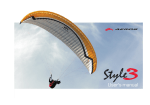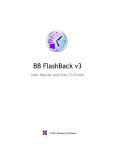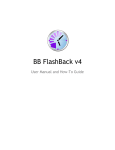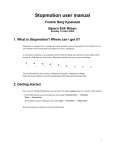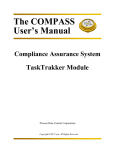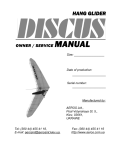Download Aeros Stranger & Stream Service manual
Transcript
TRIKE WINGS “Stranger” & “Stream” owner/service MANUAL Manufactured by: AEROS Ltd. Post-Volynskaya St. 5 Kiev 03061 UKRAINE Tel: (380 44) 455 41 18, Fax: (380 44) 455 41 16 E-mail: [email protected], http://www.aeros.com.ua Date of production: __________________________ Serial number: _______________________ 0 TABLE OF CONTENTS Section 1. General information......................................................................................... 3 1.1. Introduction...................................................................................................... 3 1.2. Main data........................................................................................................ 3 Section 2. Set up procedure............................................................................................... 4 2.1. Set up procedure from the package 4 meters long........................................... 4 2.2. Set up procedure from the package 6 meters long........................................... 7 Section 3. Preflight inspection of the glider....................................................................... 17 Section 4. Inspection of the wing....................................................................................... 25 Section 5. Maintenance..................................................................................................... 27 Section 6. Turning............................................................................................................. 28 In closing-a few final words on your safety……………………………………... 29 Section 7. Log Book.......................................................................................................... 30 Section 9. Schemes............................................................................................................. 31 1 2 Section 1. GENERAL INFORMATION 1. 1. I N T R O D U C T I O N Stranger & Stream - wings for two-seater trikes - are a product of Aeros Ltd. They are the result of an extensive design and development program aimed at optimizing your level of safety and satisfaction as a pilot, through their high performance and strength of construction. Stranger 2 is a new modification of a Stranger wing. Characteristic of this wing is different color scheme and aerofoil uprights. Stranger 2 can be used with Standard and Standard-2 hang point units only. These wings are safely controlable and stable at a wide range of operating speeds. The strength of the wings is sufficient for different conditions of flight with defined load. Please read and be sure you thoroughly understand this manual before flying your Stranger or Stream. Be sure you are thoroughly familiar with set up, break down, preflight and maintenance procedures as described in this manual. 1. 2. M A I N D A T A Stranger & Stream are high performance flexible wings for a double seater trike. Wing type Sail area, sqm Wing span, m Aspect ratio Nose angle, deg Max airspeed, kmph Stall speed, kmph (with max load) Speed of max glide angle, kmph (with max load) Range of operating overloads Total load max, kg Weight without bag, kg Stranger 15 14.8 10.2 7 126 110+ 52 70 +4-2 450 48 Stream 16 16.2 10.2 6.4 126 110+ 50 70 +4-2 450 51 After structural, aerodynamic and flight tests, the Stranger has been shown to comply with DULV requirements. Stranger & Stream were not designed to fly at bank angle over 60 degrees or pitch angle exceeding 30 degrees. Operation in any of these modes may severely compromise your safety. Flying any trike in turbulence or gusty wind can result in flight inversion, structural failure of the wing and possible fatal injuries. Performance of the wings with trilam leading edge can worsen in wet (rain, thick fog, dew, etc.) and ice-covering conditions, therefore we do not recommend to use wings in such conditions, as this can compromise your safety. 3 Section 2. SET UP PROCEDURE 2.1. SET UP PROCEDURE FROM THE PACKAGE 4 METRES LONG Having used the specific techniques described in this manual you will perform the set up and break down procedures without any difficulties. However, the following procedural descriptions are not intended to be a substitute for the familiarization procedure of your dealer at the time the wing is delivered. The set up procedure should be carried out on a clean, not abrasive surface. Before performing the set up procedure you must place the glider nose to the wind. During this procedure you must make a preflight inspection of the wing. 2.1.1. With the glider in the bag (4 metres long) lay the glider on the ground. 2.1.2. Undo the zipper. Untie the velcro straps. Remove the battens in the bags, the framebar, the leading edge tubes N3 and the nose cone from the bag. (Fig.1) Fig.1 2.1.3. Turn the glider so that the downtubes packed into the safety bags are on the bottom and kingpost is on the top. 2.1.4. Unfold the sail along the leading edge. Attach the leading edge tubes N3 to the leading edge tubes N2 according to the marking (L-left, R-right, marks must be on the top). Fig.2 NOTE: While installing the leading edge tubes into the sail place the washout struts facing forward toward the nose of the wing and along the leading edge tubes (Fig.2) 2.1.5. Rotate the bolt which is on the axle of the leading edge tube until the bolts d=6mm are positioned in the slot, closest to the nose of the wing. (Fig.3). 4 Fig.3 Remove the 6-mm bolts from the leading edge tube and put them through the grommets on the sail. Put these bolts through the holes in the channel inside the leading edge tube. Replace the plastic sadles and metal washers on the bolts from the other side of the tube. Manually secure bolts d=6 mm with selflocking nuts (Fig.4, 5). Fig.4 Fig.5 2.1.6. Rotate the bolt which is on the axle of the leading edge tube until the plastic sadles align according to the markings on the tube. (Fig.6). 5 Fig.6 If the marking is erased place the bolts according to Fig.7. Fig.7 Tighten selflocking nuts which secure the bolts d=6 mm. 2.1.7. Further set up procedure is similar tthe one from a 6-meter long bag (Section 2.2, except points 2.2.1-2.2.4). 6 2.2. SET UP PROCEDURE FROM THE PACKAGE 6 METRES LONG 2.2.1. With the glider in the bag (6 meters long) lay the glider on the ground (Fig.8). Fig.8 2.2.2. Undo the zipper. Remove the battens in the bags, the framebar and the nose cone from the bag. 2.2.3. Remove the bag and the velcro straps. 2.2.4. Turn the glider so that the downtubes packed into the safety bags are on the bottom and kingpost is on the top (Fig.9). Fig.9 2.2.5. Grasp the string loop at the front of the nose batten and pull the forked batten-end up over until it sits on the top of the keel tube (Fig.10). 7 Fig.10 2.2.5A. For Stream and Stranger 2: Grasp the string loop at the front of the nose battens and put in the corresponding hole pin of the nose battens. Fig.10A 2.2.6. Spread the wings so, that the sail is a little loose and the glider is resting flat on the ground. NOTE: Take care that the reflex wires and the top wires are not wrapped around the keel and are free from the keel hardware. 8 Fig.11 2.2.7. Attach the hook of the top rear wire and the washout wires to the thimble of the top front wire (Fig.11). Make sure that the hook is not inverted and the reflex wires or top wires are not twisted. 2.2.8. Remove the battens from the bag and lay them on the ground for each wing separately in decreasing order of length. Check them for symmetry. Correct any that are asymmetric using the template (Fig.12). Insert top surface battens from longer to shorter except two longest battens. Aeros convention is that red marked battens go in the left wing and green marked battens in the right. But you can feel free to install them the other way around, i.e. red marked battens go to the right and green marked battens go to the left. This is because Aeros do not tune glider’s turn by changing battens camber, so originally your glider comes with left and right corresponding battens symmetrical between each others. Battens are numbered from the center outwards, and the longest batten in a Stranger or Stream is designated as the "# 1" batten. Fig.12 9 NOTE: Two longest battens are not removed from the battens pockets during the break down procedure. 2.2.9. Secure the rear end of each top surface batten by first looping the bottom loop of leech line around the notched batten end, and then attaching the top loop using the extra loop as a handle (Fig.13). When attaching the leech line loops to the battens to which the reflex wires come, be sure the leech line loops are not caught underneath or wrapped around the reflex wires. Fig.13 2.2.10. Spread the wings all the way and check all wires for twisted thimbles or tangs (Fig.14). Fig.14 10 2.2.11. Remove the safety bags from the downtubes. Spread the downtubes. Install the framebar according to the marking. Fix the framebar using nuts and safety rings (Fig.14, 15). Fig.15 Fig.16 2.2.12. Pull the rope which is sticking out from the keel pocket until you will see the crossbar sweep wires. Remove the nut and the safety ring from the bolt which is secured to the crossbar sweep wires (these wires are attached to the crossbar center). Insert the bolt which is attached to the crossbar wire through the hole in the keel tube nearest to the nose of the wing. Fit the thimble of the other wire over the bolt and secure the assembly with nut and safety ring (Fig.17, 18). 11 Fig.17 Fig.18 Remove the rope from the crossbar sweep wires ! 2.2.13. Insert the tip battens until they are stopped on the stop details of the leading edge tubes and fix them using the leech lines (Fig.19). 12 Fig.19 Install the shortest of the bottom surface battens into the battens pockets. Fix the tip battens and the shortest of the top curve battens by rubber ropes from undersurface side - only for Stranger (Fig.20, 21). For Stranger Fig.20 13 For Stranger Fig.21 2.2.14. Put the glider on the A-frame. Secure the lock of the bottom wires on the nose junction channel using the clevis pin and the safety ring (Fig.22 or 22A). For Stranger Fig.22 14 For Stream & Stranger 2 Fig.22A 2.2.15. Check the nuts which secure the down tubes to the channel and the nut which secures the channel of uprights to the keel. Check also the nut which secures the kingpost channel to the keel. Check the nuts and safety rings which secure the hang detail. Aeros Standard hang units Fig.23 15 Antares hang units Fig.24 2.2.16. Install the bottom surface battens. The longest bottom surface batten is inboard batten. Push the battens all way into the pocket until the rear end is secure in the batten pocket. The strings on the rear ends of the bottom surface battens are to facilitate removal of the battens from the sail during breakdown (Fig.25). Fig.25 2.2.17. Install the washout tips, pushing them into the sleeves in the leading edges. 2.2.18. Remove the protective bag from hang detail. 2.2.19. Do a complete preflight inspection of the glider, Section 3. 16 Section 3. PREFLIGHT INSPECTION OF THE GLIDER 3.1. Do a complete preflight inspection of the glider. It is your responsibility during this "preflight" to check every part, component and assembly on the glider. Beginning at the nose, check all selflocking nuts, the clevis pin and the safety ring which secure the lock of the bottom front wires (Fig.26/27). Fig.26 Fig.27 17 3.2. Look through the nose hole and inspect each leading edge. Check that all bottom surface battens are under the leading edge tube. (Fig.28). Fig.28 Make sure that the spring buttons from the inserted leading edge tubes N3 are sticking out fo the tube surface. Check for any evidence of dents, deep scratches, cracks or bends in the leading edge tubes (look for signs of crystallization of the material: a brighter, fuzzy spot on the aluminium). 3.3. Check that the mylar has no bends. 3.4. Look through the open bottom surface pockets near the crossbar/leading edge junction and check that this junction is safely secured with the castle nut and the safety ring. Check that top and bottom side wires are attached to the crossbar/leading edge junction properly. Check that wires are not twisted and are not caught up. (Fig.29/29A). 18 Stranger Fig.29 Stream and Stranger 2 Fig.29A Zip the zipper near the crossbar/leading edge junction closed. 3.5. Look into the sail at each wing tip, and check that the tip battens are properly seated and fixed with the leech lines and rubber ropes - for Stranger (Fig.30) and for Stream (Fig.30A). 19 Fig.30 Fig. 30A Check that the washout tips are installed properly into the holes in the leading edge tubes. Be sure that the batten tension leech lines are equally tensioned. To provide flight without spontaneous turn the bolts of the sail tension on the console ends must be positioned according to marking. 3.6. Check the trailing edge for any cuts, tears or broken stitching. 3.7. Check that the top surface battens are fixed with the batten tension leech lines. 3.8. Check that each of the reflex wires are free from the batten tension leech lines and the reflex safety ring is flush with the bottom of the sail - for Stranger (Fig.31). Check fixing of quick links of reflex wires - for Stream (Fig.31A). 20 Fig.31 Fig.31A Check that no reflex wire is looped underneath a more inboard batten (Fig.32). Fig.32 21 3.9. Check that the top rear wire, the keel mount webbing, and bottom rear wires are safely secured to the keel tube using the nut and the safety ring (Fig.33). Fig.33 3.10. Check all bolts, nuts and the safety rings which secure the downtubes to the channel. Make sure that the channel to the keel and hang detail are secured (Fig.34, 35). 22 Fig.34 Fig.35 3.11. Check that the bolt of the crossbar tension wires is secured by the nut and safety ring (see Fig.33). 3.12. Check the thimble fittings at the control bar corners for any cocked or twisted thimbles and lugs. If you find any, straighten them out (if necessary, detention the crossbar and bottom wires). If you find a kink in the cable, you must replace it, or their is a danger it will fail after repeated loading and unloading. Check the nuts and safety rings at the lower control bar corners (Fig.36). 23 Fig.36 3.13. Fit the nose cone over the front of the keel and attach the velcro at the top rear of the nose cone. Rest the glider back on it's tail and pull the bottom corners of the nose cone back until the nose cone is tight around the nose and secure the velcro on the bottom of the nose cone (Fig.37, 38). Fig.37 24 * Fig.38 Now your glider is ready for mounting on the trike. Don’t fly without the nosecone! Section 4. INSPECTION OF THE WING The sail should be inspected once every three months or after each 50 flying hours. The frame should be inspected once a year, after every 100 flying hours, and after every hard landing. 4.I. SAIL CHECK-UP 4.1.1. Sail seam and cloth strength are assessed by testing the strength of the control clouts on the top surface (TS) of the wing. The control clouts are incorporated in the cloth piece (designated by letters UV) that is sewed onto the trailing edge close to the keel tube. For sail assessment cut control clout in the drawing and forward it to your Aeros dealer or directly to Aeros. The first sample is to be cut out after 300 flying hours and thereafter a sample must be submitted after every 150 flying hours. 25 4.1.2. Checking the sail surface and seams. There should be no cuts, ruptures, threadbare holes and torn seams on the sail. Any torn seams should be re-stitched. Cuts and ruptures on the fairing and bottom surface (BS) of the sail that are not longer than 30 mm can be patched up with self-adhesive Dacron. The Dacron must be of a weight of not less than 100 g/m. Larger cuts and ruptures are to be repaired by stitching on a reinforcing piece of the same fabric (stitched along the edges). Any rupture shorter than 50 mm can be repaired in this manner, but more complicated repairs should be carried out in the workshop of producing company. If any of the batten tightening cords are torn or heavily worn they must be replaced. 4.1.3. Keep an eye on the sail grommets/eyelets and all areas of the sail that are subject to extra stress, especially the keel section, the nose section of leading edge and the outer tip section of leading edge. 4.2. CABLE SYSTEM The cables must be checked for broken wires. If any defect on a wire is observed, no matter how small, the cable in question MUST BE REPLACED. It is recommended that the entire cable system be replaced once every two years irrespective of service conditions. A NOTE ABOUT CABLES AND CABLE MAINTENANCE The cables which support the wing’s airframe are critical components of the wing’s structure, and must be maintained in an air worthy condition. It is a general practice in the design of aircraft structures to design to an ultimate strength of 1.5 times the highest expected load in normal service. Stranger or Stream cables, like other structural components on the wing, are typically designed with a structural safety factor of only about 50% above the expected maximum load. No significant loss in cable strength can be tolerated. A cable with even a single broken strand must be replaced before the wing is flown again. A cable which has been bent sharply enough to have taken a permanent set must also be replaced immediately. 26 Some degree of fatigue due to repeated bending of cables is almost unavoidable in an aircraft that is assembled and disassembled with every flight. Bottom side wires are subject to the highest loads in flight, and are therefore the most critical. 4.3. CHECKING THE TUBINGS To check the condition of the wing tubes the sail should be removed from the wing frame and the tubes should be detached at the joints. The tubes are to be inspected visually. When there is suspicion of damage, the points in question should be inspected using a magnifying glass of (5-10)X magnification. There should be no trace of corrosion, cracks, bends or dents. 4.4. CHECKING THE BATTENS The batten profiles should be checked against the template and the bends should be adjusted if necessary. Check all the plastic batten heads and tails and replace if necessary. 4.5. FASTENERS Check all fasteners (bolts, screws, rollers, nuts, splint pins etc.) for corrosion. Any corroded fasteners should be replaced. Bolts should not be worn and/or bent. Key bolts should be checked most thoroughly for cracks between the head and the bolt body. These are the bolts at the control bar side and bottom joints, the central spreader bar tensioning cable attach point and the rear cable attachment point on the keel tube. If any cracks are observed - REPLACE IMMEDIATELY! Section 5. MAINTENANCE 5.1. MAINTENANCE • With correct maintenance your wing will retain its good condition for many years. • We recommend that do you not expose your wing to any more direct sunlight than necessary. Do not leave it standing in the sun for long periods of time when you are not flying it. • Do not leave your wing on the trike for a long period of time when the wind is strong. It will decrease the life of the sail, hang junction and frame of your wing. • Your wing should be dried thoroughly after being exposed to rain or any other source of moisture. • Your sail should never be washed with anything other then fresh water, as any soap or detergent will most likely degrade the cloth and may adversely affect the flight characteristics of your wing. • When you set up or break down your wing, take care not to allow sand, soil and dirt to enter the sail, batten pockets or tubes. Keep the leading edge tube telescopic connectors thoroughly clean as set up or break down will become difficult or impossible if they are dirty. Swab the tubes with a rag. • Keep all the wing’s foam padding that was originally supplied and use in the same places when re-packing the wing. 5.2. STORAGE • You must store the wing in its bag in a dry place on soft bedding. Before storage you must ensure that the sail is dry. • The frame of the wing must not be subjected to load during storage and the tubes must not be bent under their own weight. • The wing can be storage in temperatures ranging from -10°C to +25°C. 5.3. TRANSPORTATION • The wing may be transported in its bag in any vehicle that offers protection from mechanical damage, soiling and long exposure to rain. It is not recommended that the wing be carried or transported without its bag. 27 Section 6. TURNING 6.1. FINE TUNING THE WING Your wing has, on each side, a tensioner bolt that can be turned to 'wind up' (tighten) the sail on either side. This bolt can be found on the very tips of your wing's leading edge tubes and requires the use of a 17 spanner. If your wing has, for example, a right turning tendency this means that more angle of attack is required on the right side to bring this wing up to level flight. To do this, simply screw the right side tensioner bolt clockwise by 2 to 3 turns. This tightens the sail on that side of the wing, effectively increasing the angle of attack. NB: As this point you may need to slightly loosen the two 6-mm bolts that secure the sail to the leading edge. This is in order to ensure smooth movement of the sail during the adjustment. Test fly. If there is still a right turn, you may screw 'out' the other side (left side). Simply turn the left side tensioner bolt anti-clockwise 2 to 3 turns. Test fly and repeat the process if necessary. You may “wind” or “unwind” the sail on each side to a maximum of 12mm distance from its original position - this can be measured by looking at the position of the two 6-mm sail securing bolts on each side. If you reach this maximum and the wing still has a right turn, reset your wing to its original settings and proceed with coarse wing adjustment. 6.2. COARSE WING ADJUSTMENT (Note: Ensure that your wing adjusters are restored to their original settings before attempting coarse adjustment.) You will notice if you look inside the sail at the wing tips, that the end piece of the leading edge tube is adjustable about its longitudinal axis. The tip leading edge tube section fits into the main leading edge tube and is secured in place with a small screw. This tip piece can be rotated through three positions (three securing holes available on the main leading edge piece). The wing is delivered standard with both wing tips set in their maximum angle of attack position. To correct a right turning tendency, the left side needs a decrease in angle of attack - this will decrease the lift on the left side and bring this wing down resulting in level flight. Do this by adjusting the left tip leading edge piece 'up' one position (less angle of attack). This may require some de-tensioning of the tip adjusters to give the necessary slack required to rotate the tip piece. Test fly and repeat if necessary. If you adjust until you are in the third adjustment position on the left side and the wing still has a right turn you may go through the steps of fine tuning your wing (you may fine tune your wing at any coarse adjustment setting). If the turning problem still persists, please contact Aeros LTD or your dealer for advice. 28 IN CLOSING - A FEW FINAL WORDS ON YOUR SAFETY UL flying is an active air sport with associated risks. Your safety can be greatly enhanced by following a few simple rules: Your wing is delivered to you ready to fly. Do not make any adjustments, which are not described in this manual. If you are in doubt about any aspect of your wing you should consult your dealer or Aeros for advice. Only fly after having attended a good school. Fly a wing suited to your level of ability. A new risk may arise when you first fly a new type of the wing. The reactions of your new wing may well differ from those of the wing you where used to. In order to keep this risk low, we recommend that you gradually become familiar with your new wing. Before every take-off always do both an assembly check and a pre-flight check. Do not take off if the sail is wet, especially the leading edge, as the stall speed will increase significantly. Always fly with a dry sail! Take special care to avoid ice covering the glider, particularly the leading edge in wintertime. A wet wing must be dried before storing. Do not leave your glider wet for more than one day, because corrosion may result. Never fly alone. Don’t push your luck. It is your responsibility to know the limits of your wing and the limits of your own experience. Remember, that ultimately your safety is your responsibility. Fly only in places, which are suitable for flying. With proper care and maintenance, your wing will retain a high level of airworthiness for many years. Have fun. Fly safely. Aeros Team 29 Section 7. LOG BOOK TABLE OF FLIGHT HOURS DATE NUMBER OF FLIGHT TOTAL HOURS 30 BY WHOM 34 STG.B.134.000 WASHOUT STICK CAP BLIND STG.B.133.000.AD RIVET 34400 4X6 WASHOUT STICK STG.B.132.000 BUSH 3 ,6 5 1 WASHAUT MOUNTING 2 5 00 2 5 BLIND RIVET 34400 4X6 SS2515 HOOK STL116000AD BUTTON SPRING STG.B.130.003.WD SHOCK CORD BLIND BLIND RIVET RIVET 34400 4X6 34400 4X6 STG.B.131.001 TUBE N3 AEROS by: Zakidyshev Date: 09.10.03 RIGHT STG.B.130.001.AD ASSEMBLED LE TUBE N3 RIGHT Scale: 1 4 1 2 5 3 Parts List Item Qty 1 1 STG.B.310.003.WD 2 1 STG.B.310.005.WD Name Material D16T ∅2.5 ∅14x1 7x7 Vendor L=1565 WR77023 Note TUBE LINDEMANN CABLE L=273 3 1 STG.B.311.000 PLASTIC BATTEN TIP FORK AEROS by: Zakidyshev Date: 03.12.03 4 1 PRF15.346.000 5 1 NT282G STG.B.310.000.AD KEEL BATTEN PLASTIC . BATTEN LINDEMANN PRESS TIP SLEEVE Scale: 2 1 3 Parts List Item Qty Name Material 1 1 STG.B.312.003.WD D16T 2 1 STG.B.311.000 PLASTIC ∅12x1 L=2410 Vendor Note TUBE BATTEN TIP FORK 3 AEROS by: Zakidyshev Date: 03.12.03 1 PRF15.346.000 STG.B.312.000.AD ASSEMBLED TOP SURFASCE BATTEN N1 PLASTIC BATTEN TIP Scale: 3 2 4 1 5 Parts List Item Qty Name Material Vendor Note 1 1 STG.B.314.003.WD D16T ∅12x1 L=1435 TUBE 2 1 STG.B.311.000 PLASTIC BATTEN TIP FORK 3 1 STG.B.315.000 PLASTICK 4 1 STG.B.316.000 B95T ∅12x1 TUBE 5 1 PRF15.346.000 PLASTIC BATTEN AEROS by: Zakidyshev Date: 03.12.03 TIP STG.B.314.000.AD ASSEMBLED TOP SURFASCE BATTEN N3 Scale: 2 2 1 Parts List Item Qty 1 1 Name STG.B.325.003.WD Material B95T ∅10x0.75 Vendor Note TUBE L=1670 2 AEROS by: Zakidyshev Date: 13.06.02 2 STL362000 PLASTIC STG.470.000.AD ASSEMBLED BOTTOM SURFACE BATTEN BATTEN TIP Scale: N1 2 1 Parts List Item Qty 1 1 STG.B.332.003.WD D16T 2 1 STG.B.311.000 PLASTIC Name Material ∅12x1 L=540 Vendor Note TUBE BATTEN TIP FORK AEROS by: Zakidyshev Date: 05.12.03 STG.B.332.000.AD PLUG-ON BATTEN Scale:




















































